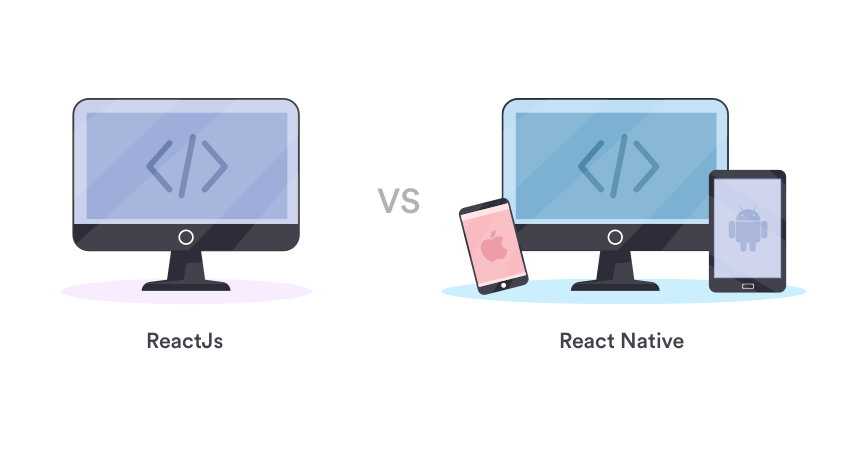
React Js and React Native are pretty similar technologies. However, there are some differences that one needs to be aware of before they start developing their first native app or website. Today, we will be talking all about what React Js and React Native are, and the main differences between them. Read down below to find out more. React Js is an open-source, component-based library intended for front end development. It is primarily used to build user interfaces for single-page applications. JavaScript on the other hand is a text-based programming language used in web development to create interactive, dynamic and scalable websites and web applications. It is responsible for adding interactive elements to the websites such as videos, animations, graphics and more. React Native was created by Facebook and it is an open-source mobile application framework. So, basically it allows web developers to develop effective mobile applications using their existing knowledge of JavaScript. React Native is used to develop apps for iOS, Web, UWP, macOS, Android, TvOs and Android TV by allowing developers to use both; their native platform, as well as React framework capabilities. Let's have a look at some of the advantages of React Js and React Native which help them differentiate from one another. The advantages of React native are: 1. Can be used across different platforms One of the biggest benefits of React native is that it needs to be learned once, but can be written everywhere. It supports both Android and iOS devices. 2. You can easily develop apps You can easily build native mobile apps if you hold JavaScript knowledge. 3. Offers optimal performance React Native works great at improving performance with the help of native modules and control. 4. Development is quicker Thanks to pre-developed components available in the open-source library, the development doesn’t take as much time as compared to other programming languages. 5. Hot Reloading You can view the changes being made to your app's code during the development. Moreover, developers can also select specific components and examine and edit their current state and props. 6. Large community of developers React JavaScript and React Native have a large community of developers, which allows developers to easily find answers to any questions they might have regarding the code. The advantages of React JS are: One of the main reasons so many developers enjoy working with ReactJs is because it is easy to learn and use. It can be understood easily by any developer who is familiar with JavaScript background. Working with React JS is much easier, and it is possible to create dynamic web applications much quicker because less coding is required. Whereas, creating dynamic web apps with HTML is much more difficult as it involves complex coding. React Js is certainly not a passing trend. It’s actually a mature and stable technology, and its use is only expected to further increase in the coming years. Its support of a handy set of tools makes the development task quite hassle-free and understandable for developers. Let's have a look at some of the drawbacks of React Native and React Js. The drawbacks of React Native are: If you are a newbie in the app development field, then you might find it difficult to learn the language from scratch. Since it is an open-source framework and a JavaScript library it’s not the best in terms of security robustness. Also, it is advised by experts to not choose React Native for developing financial and banking apps. Since React Native is built using JavaScript, C / C ++, Java and Objective-C it is more difficult for developers to debug bugs, for which knowledge of the native language of the platform might be needed. Initially, only the iOS platform was supported by React Native. Later on, Android support was released later on only in subsequent releases. This is one of the main reasons React Native is linked with inferior android support. Read down below to find out the disadvantages of React Js and React Native. The drawbacks of React Js are: This is actually both; good and bad. Since React is still a newer language it is evolving very quickly. Therefore, its new features are getting rolled out at a pretty fast pace, which somewhat makes it difficult for developers to keep up with the newer features. Since React only covers the ReactJS it only covers the UI Layers of the app and nothing else, developers need to rely on other technologies as well. However, this is also viewed as a plus point by some developers as it offers full independence. Since React JS is constantly evolving and the library is getting updated frequently, the React documentation is poor. Though React Js and React Native hold a lot of similarities, there are also some notable differences between the both. Let’s have a look: Each technology in the realm of development comes with its own benefits and set of drawbacks, same is the case with React Native and ReactJS. Whether you should choose React Native or ReactJS is a question that would require you to weigh the pros and cons of both technologies in order to come up with the right answer for yourself. What is React JS?
What is React Native?
React vs React Native – The Pros and Cons
Advantages of React Native
Advantages of React JS
React vs React Native – The Limitations and Drawbacks
Drawbacks of React Native
Drawbacks of React JS
Differences Between ReactJS and React Native?
React JS
React Native
It is used for web app development
It is used for mobile app development
It was initially released in 2013
It was initially released in 2015
React Js uses HTML tags
React Native does not use HTML tags
It provides robust security
The security feature of React Native is not very robust
The learning curve is easy
It is difficult to learn for newbies
It uses React-router for navigating web pages.
It features an in-built navigator library for navigating mobile apps.
Ideal for building high-performing, interactive and dynamic UI for your web interfaces
Ideal for giving mobile apps a truly native feel
Conclusion








